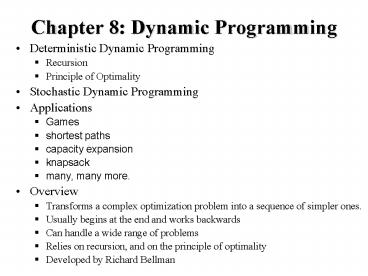Chapter 8: Dynamic Programming - PowerPoint PPT Presentation
1 / 8
Title:
Chapter 8: Dynamic Programming
Description:
Transforms a complex optimization problem into a sequence of simpler ones. ... States: The description of the smaller subproblems is often referred to as the ... – PowerPoint PPT presentation
Number of Views:54
Avg rating:3.0/5.0
Title: Chapter 8: Dynamic Programming
1
Chapter 8 Dynamic Programming
- Deterministic Dynamic Programming
- Recursion
- Principle of Optimality
- Stochastic Dynamic Programming
- Applications
- Games
- shortest paths
- capacity expansion
- knapsack
- many, many more.
- Overview
- Transforms a complex optimization problem into a
sequence of simpler ones. - Usually begins at the end and works backwards
- Can handle a wide range of problems
- Relies on recursion, and on the principle of
optimality - Developed by Richard Bellman
2
Deterministic Dynamic Programming
- Elements of a DP model
- Stages one solves decision problems one stage
at a time. Stages often can be thought of as
time in most instances. - Alternatives at each stage options to be
selected - States The description of the smaller
subproblems is often referred to as the state
(si) information links stages together - Recursive function (forward/backward)
- Express the relationship between fi(si) and
fi1(si1) - Express si1 as a function of si
- Principle of Optimality
- Whatever the current state and decision, the
remaining decisions must constitute an optimal
policy regardless of the policy adopted in
previous stages - E.g. Whatever node j is selected, the remaining
path from j to the end is the shortest path
starting at j.
3
Deterministic Dynamic Programming
- Problem formulation Consider state variables,
si, decision variables, xi, stage contribution,
Ci(si, xi), a objective function,
fi(xn,,xn-i,sn), and a transformation function,
ti(xi, si) - Solution procedure solve recursively the
following
4
Example 1
- Shortest-route problem select the shortest route
between 2 nodes - Elements of the DP model
- Stage layer of nodes
- State node si at stage i
- Alternatives are represented by the routes from
node si at stage i to other nodes si1 at stage
i1 - Recursive function
- Difference between stages (stage rewards)
distance d(si-1,si) - Relationship between stages
- Relationship between states of stages d(si-1,si)
- Starting stage f0(s0) 0 (or fn(sn) 0 if
backward recursion)
5
Stochastic Dynamic Programming
- Problem formulation Let S is the number of
possible states at stage n1. The system goes to
state i (i 1,2,,S) with probability pi given
state xn and decision dn at stage n. If the
system goes to state i, Ci(xi,di) is the
contribution of state i at stage n to the
objective function - SDP ? decision tree
- Recursive function identify optimal policy for
stage n, given the optimal policy for stage n1
is available
6
Stochastic Dynamic Programming
7
Example 2
- An individual wishes to invest up to C 10000
in the stock market over the next n 4 years.
The investment plan calls for buying the stock at
the start of the year and selling it at the end
of the same year. Accumulated money may then be
reinvested (in the whole or part) at the start of
the following year. The degree of risk in the
investment is represented by expressing the
return probabilistically. A study of the market
shows that the return on investment is affected
by S (favorable or unfavorable) market conditions
and that condition i yields a return Ci with
probability pi, i 1,2,,S. How should the
amount C be invested to realize the highest
accumulation at the end of the n years? If S 3
represents for the chance to double, break even
and lose amount of money, respectively we have
the following information p1 0.4, p2 0.2, p3
0.4 and C1 1 C2 0, C3 -1
8
Example 2
- Let xi amount of funds available for investment
at the start of year i (x1 C) - yiamount actually invested at the start of year
i (yi xi) - Stage i is represented by year i
- The alternatives at stage i are given by yi
- The state at stage i is given by xi
- Recursive function
- Given that market condition k occurs with
probability pk and fn1(xn1) xn1 because no
investment occurs after year n. we have - For market condition k































